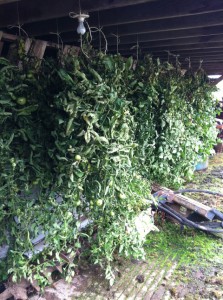Much of this year’s work has been an experiment. Some of it is qualitative, like “do we enjoy this?” But much of it is quantitative, to see how much of what we can get how quickly from a square foot of ground. These numbers are really important to help us make realistic business projections for the coming year, and also to give us more general information, like “how well do tomatoes of different varieties grow in this microclimate?”
 Whenever we’ve mentioned tomatoes, people around here say that you really need a greenhouse if you want to grow them. The season starts too late, so you can’t get them to market in time, and the summer is not hot enough, so many of them won’t ripen before the fall rains come and you lose the whole mess to blight. Despite the warnings, we tried them anyway. We’ve learned that much of the local farm wisdom is dead-on, but sometimes it pays to try weird stuff, as you can get surprising successes from time to time that really open up your options… our deeply dug beds with close crop spacing is a good example.
Whenever we’ve mentioned tomatoes, people around here say that you really need a greenhouse if you want to grow them. The season starts too late, so you can’t get them to market in time, and the summer is not hot enough, so many of them won’t ripen before the fall rains come and you lose the whole mess to blight. Despite the warnings, we tried them anyway. We’ve learned that much of the local farm wisdom is dead-on, but sometimes it pays to try weird stuff, as you can get surprising successes from time to time that really open up your options… our deeply dug beds with close crop spacing is a good example.
In the case of tomatoes, though, the local wisdom has proved accurate. Ginger at Revolution Gardens has a greenhouse, and her tomatoes were ready the second week of market, nearly two months before ours, and they came in abundance. Our cherry tomatoes, the fastest-growing of the varieties we planted, finally started turning red the last week of the market. They trickled in for about a week, then the summer ended with a big wind and rain storm, crushing our plants to the ground as the cool weather effectively stopped any further growth. The result? Hundreds of pounds of green tomatoes that will never ripen.
 A lot of people felt bad for us when they heard this happened, but really, I’m not upset at all. The experiment was a success. We know that we can grow a LOT of tomatoes in a tight space (like I said, HUNDREDS of pound of green ones) and we also learned that getting a greenhouse is a high priority item before next season.
A lot of people felt bad for us when they heard this happened, but really, I’m not upset at all. The experiment was a success. We know that we can grow a LOT of tomatoes in a tight space (like I said, HUNDREDS of pound of green ones) and we also learned that getting a greenhouse is a high priority item before next season.
And the tomatoes themselves? Not a guaranteed loss… I cut down all the vines, and hung them to dry in Farmer Ned’s retired cow barn. They say that if tomatoes are hung somewhere dry and you have patience, they will oftentimes ripen and be salvageable for spaghetti sauce, salsa, and so forth. I’ll let you know how that goes.
Oh, and in other news, the market season is over, so we took last week’s harvest to a friend of ours who is a restauranteur. She bought the whole truck’s worth of produce, including pumpkin, squash, sweet corn, beets, cucumbers… and we gave her half a bucket of cherry tomatoes for free.

